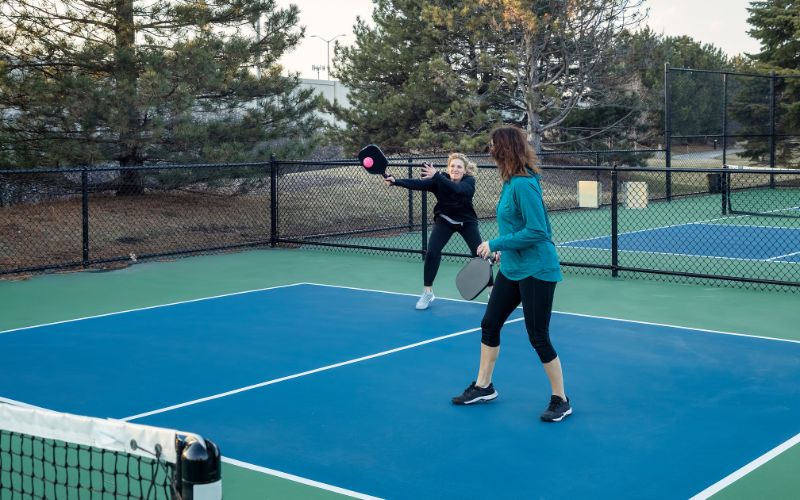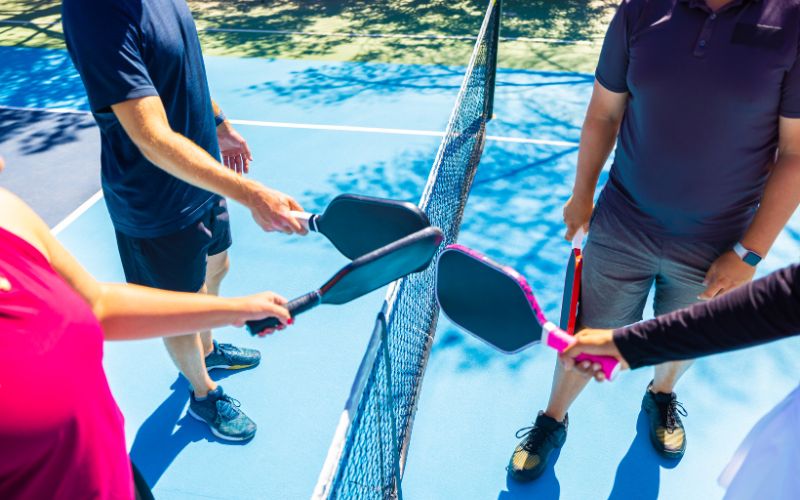Pickleball has rapidly gained popularity, not only among sports enthusiasts but also within the construction industry. While the sport is exhilarating and accessible for all ages, understanding its pickleball scoring system is crucial for an enjoyable game. In this comprehensive guide, we’ll delve into the intricacies of pickleball scoring, from the basics to player positioning and scorekeeping. So whether you’re a seasoned pro or a beginner looking to up your game, let’s explore the ins and outs of pickleball scoring system
What Score Do You Need to Win in Pickleball?
Before we dive into the nitty-gritty of pickleball scoring, it’s essential to know what score you need to achieve to win a game. In pickleball, you typically play to 11 points, but you must win by at least two points. However, there are variations in scoring, such as playing to 15 or 21 points in some instances. The specifics of scoring can vary based on the level of play and local rules, so it’s always a good idea to clarify the rules before starting a game.
Basics Scoring Rules
Basics Scoring Rules for Double Pickleball
In pickleball, doubles play is a popular format, and understanding the scoring rules for doubles is fundamental. Here’s how it works:
Service Rotation: The game commences with the serving team, with one player initiating an underhand serve diagonally from the right side of the court. Subsequently, following each point, the serve shifts to the next player on the serving team.
Scoring: In doubles, points can only be scored by the serving team. If the serving team wins a point, they continue to serve. If the receiving team wins a point, they get the serve. If the receiver fails to return the ball to the server then it is a server score points
Faults: Common faults during service include stepping on or over the baseline, not letting the ball bounce before serving, or serving into the non-volley zone (the seven-foot area adjacent to the net).
Side-Outs: When the serving team commits a fault or loses a point, it results in a “side-out.” The receiving team then takes over the serve.
Winning: The game is won by the first team that reaches a score of 11 points (or another specified score) while keeping a lead of at least two points over the serving team’s score and the receiving team’s score.
Basics Scoring Rules for Single Pickleball
Singles pickleball has some scoring differences compared to doubles, even though many of the fundamentals remain the same:
Service: In singles, the server starts on the right-hand side and serves diagonally to the opponent’s right-hand side of the court. Like in doubles, service alternates between players as points are won or lost.
Scoring: As in doubles, only the serving player has the opportunity to score points. If the server wins a point, they retain the serve, while a point won by the receiver results in a service change.
Faults: Faults during service, such as stepping over the baseline or not allowing the ball to bounce before serving, still apply.
Side-Outs: Just like in doubles, when a fault or point is lost, it leads to a side-out, with the receiver taking over the serve.
Winning: The first player to reach 11 points (or another specified number) while holding a lead of at least two points wins the game.
Now that we’ve covered the basics of scoring in pickleball, let’s move on to player positioning and how to keep track of the score effectively.
Player Position
Player Positioning for Doubles Pickleball
In doubles pickleball, positioning on the court is crucial for success. Proper player positioning can help you control the game, make strategic shots, and maximize your chances of winning. Here are some key positioning tips for doubles play:
Stay at the Baseline: In doubles, players generally start at the baseline to provide ample coverage of the court. This positioning allows for effective shot placement and quick movements.
Work with Your Partner: Communication and teamwork are vital in doubles pickleball. You and your partner should coordinate to cover the court efficiently and avoid leaving open areas.
Stay Out of the Non-Volley Zone: The non-volley zone, also known as the “kitchen,” is a seven-foot area adjacent to the net where players are not allowed to volley the ball. Avoid entering this zone unless the ball has bounced.
Be Ready to Transition: Be prepared to move forward when the opportunity arises. Transitioning to the non-volley zone to put pressure on your opponents can be an effective strategy.
Use the “Two-Up, Two-Back” Strategy: A common formation in doubles is having both players at the baseline, ready to advance or retreat as the point unfolds. This formation provides excellent court coverage.
Lob and Dunk Shots: Utilize lobs and dinks strategically to gain control of the net and create scoring opportunities.
Player Positioning for Singles Pickleball
Positioning in singles pickleball has some distinctions compared to doubles. Since there’s only one player on each side, the dynamics change. Here are some essential positioning tips for singles play:
Cover the Whole Court: In singles, you’re responsible for covering the entire court, so effective movement and positioning are crucial.
Stay at the Baseline: Start at the baseline, but be ready to move forward when necessary. Maintaining a good balance between offense and defense is key
Manage the Non-Volley Zone: Like in doubles, avoid entering the non-volley zone unless the ball has bounced. Skilled players can exploit your position near the net.
Stay Agile: Singles require more agility and lateral movement. Being quick on your feet and anticipating your opponent’s shots can make a significant difference.
Now that we’ve covered player positioning, let’s delve into how to call the score in pickleball and what happens if the wrong score is called.
How to Call the Score in Pickleball
Properly calling the score in pickleball is an essential aspect of the game. It ensures that both teams are on the same page and eliminates confusion. The score is called using a specific format that includes three key elements:
Server’s Score: The score is always called starting with the server’s score. For example, if the serving team has 3 points, you would say “3.”
Receiver’s Score: After stating the server’s score, you move on to the receiver’s score. For instance, if the receiving team has 6 points, you would say “6.”
Server Number: The last element in the score call is the server number. In doubles, this is typically “1” or “2” to indicate which player is serving. In singles, you don’t need to specify the server number.
Putting it all together, if you’re the first server in a doubles game and your team has 3 points while the opposing team has 6, you would call the score as “3-6-1.”
What Happens If the Wrong Score Is Called in Pickleball?
Mistakes happen, and calling the wrong score can occur even among experienced players. However, it’s essential to correct any errors promptly. If the wrong score is called in pickleball, the following steps should be taken:
Acknowledge the Mistake: The first step is to recognize the error. This can be done by any player on the court.
Correct the Score: Once the mistake is acknowledged, the correct score should be called immediately. This ensures that both teams are aware of the actual score.
Resume Play: Play can continue from the corrected score without any penalty. The mistake is usually rectified without major interruptions.
In a more competitive setting, failing to correct the score may lead to disputes, so it’s always best to ensure accuracy in your score calls.
Asking the Referee the Pickleball Score
In some organized tournaments or matches, a referee may be present to oversee the game and assist with scorekeeping. If you’re unsure of the score or there’s a dispute, you can ask the referee for clarification. Referees typically have an extensive knowledge of the rules and are responsible for ensuring fair play and accurate scorekeeping.
Now that we’ve covered how to call the score and handle mistakes, let’s explore how to keep track of the score in pickleball effectively.
How to Keep Track of the Score in Pickleball
Keeping track of the score in pickleball can be managed in various ways, depending on personal preferences and available resources. Here are some common methods to help you maintain an accurate score during the game:
Verbal Announcements: Players can verbally call out the score after each point. This method is common in casual games and helps everyone on the court stay informed.
Use of Scorecards: Scorecards are a practical way to track the score. Each team or player can maintain a scorecard, updating it after each point. Many pickleball-specific scorecards are available for purchase, making this method easy and convenient.
Electronic Scoreboards: Some pickleball courts are equipped with electronic scoreboards that automatically update the score as points are won. This is a high-tech option that ensures accuracy.
Manual Scoreboards: Manual scoreboards, often resembling small flip signs, can be attached to the net or placed nearby. Players or a designated scorekeeper manually flip the numbers to update the score.
Mobile Apps: Several mobile apps are available for scorekeeping in pickleball. These apps allow players to input the score easily and track it on their smartphones.
Score Chalkboards: A chalkboard placed near the court can be used to write and update the score manually. This method is common in casual and outdoor games.
Conclusion
The choice of scorekeeping method largely depends on the level of formality in the game and the available resources. In more competitive settings, electronic scoreboards or mobile apps are often preferred for their accuracy and convenience.
As we wrap up this comprehensive guide to pickleball scoring, it’s clear that understanding the scoring system and player positioning is critical to success in this dynamic and enjoyable sport. Whether you’re a construction professional looking for a break from the rigors of the construction industry or a seasoned pickleball enthusiast, these insights will help you navigate the game with confidence.
Incorporating the right strategies and accurate scorekeeping methods can make a significant difference in your pickleball experience, just as effective accounting services for construction companies play a crucial role in managing the financial aspects of the construction business. As the construction industry evolves, staying informed about the changing business landscape and regulations is critical for the success and profitability of construction companies.
So, grab your paddle, hit the court, and put your newfound knowledge of pickleball scoring to good use. Whether you’re playing singles or doubles, keeping track of the score accurately and positioning yourself strategically will help you achieve success in this exciting sport. Happy pickleballing!
Frequently Asked Questions (FAQ) on Understanding Pickleball Scoring
What is the standard score needed to win a game in pickleball?
In pickleball, the standard score to win a game is 11 points, with a requirement to win by at least two points. However, variations exist where you may play to 15 or 21 points based on local rules and player preferences.
What do I call the score in pickleball?
The score in pickleball is called using a specific format: you start with the server’s score, then the receiver’s score, and the server number in doubles. For example, “3-6-1” indicates the serving team has 3 points, the receiving team has 6 points, and it’s the first server’s turn.
What happens if the wrong score is called during a pickleball game?
If the wrong score is called, it should be acknowledged and corrected immediately. Players should correct the score to ensure both teams are aware of the accurate score, and play can resume from there without penalties.
When is a referee used in pickleball, and how can they assist with scoring?
Referees are typically used in organized tournaments or matches. They oversee the game, including scorekeeping. If there’s a dispute or confusion about the score, players can ask the referee for clarification, as referees have extensive knowledge of the rules.
What are the different methods to keep track of the score in pickleball?
There are various methods to keep track of the score, including verbal announcements, scorecards, electronic scoreboards, manual scoreboards, mobile apps, and score chalkboards. The choice of method depends on the level of formality in the game and available resources.







